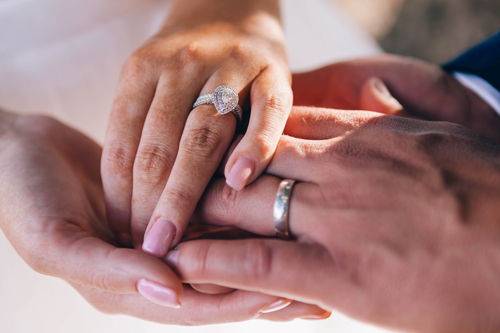A Complete Guide to Hypoallergenic Jewelry
Allergic reactions can occur when your body responds negatively to something it comes in contact with. Common types of allergens include foods like peanuts or triggers like pet dander and pollen. Many people also have metal hypersensitivity, which occurs when your body has an allergic reaction to metal ions that come in contact with your skin — like a ring or necklace.
Just because you have a metal allergy doesn’t mean you need to forgo all jewelry. Use this guide to learn more about your hypersensitivity and how to find jewelry that your immune system approves of.

What Causes Metal Allergies?
Your immune system works as a vigilante against all potential threats. For example, when it encounters the influenza virus, it perceives it as a threat to the body and responds by triggering a fever and other flu symptoms in order to eradicate the virus. Unfortunately, the human body sometimes identifies harmless items as threats, which is what occurs in people who have metal hypersensitivity. When some individuals come into contact with metal ions, their body responds with a rash, swelling, and other self-defense symptoms.
Metal hypersensitivity is more common than you might think. An estimated 10 percent to 15 percent of the population lives with this condition. Here are a few of the most common allergy-causing metals:
- Nickel: up to 17 percent of women and three percent of men are allergic to this metal.
- Cobalt: one percent to three percent of the population are allergic.
- Chromium: one percent to three percent of people are allergic.
While these are the most common metals to have a hypersensitivity to, you can develop an allergic reaction to almost any metal as you get older.
Hypoallergenic Metals for Jewelry
The first thing you need to know is that hypoallergenic means it is only slightly allergenic, not completely allergy-proof. Hypoallergenic jewelry only carries trace amounts of allergy-causing chemicals but isn’t completely free of them. This means some people will have a harder time finding hypoallergenic jewelry than others. If you have severe metal hypersensitivity, even hypoallergenic options might trigger a reaction.
Fortunately, because metal hypersensitivity is so common, it’s not hard to find hypoallergenic jewelry options to test out. You should be able to find jewelry for day-to-day use — like your wedding ring or band — that doesn’t cause a reaction. Here are a few options to consider.
Platinum
Platinum is a favorite option for people with metal allergies. Not only does the bright silver shine look beautiful, but it is less likely to cause a reaction on your skin. Platinum is 95% pure, which is why many jewelers recommend this option for people who are allergic to various metals. Gold and sterling silver, by contrast, are often mixed with several metal alloys. Even one of these alloys can trigger a reaction. Platinum also doesn’t have any nickel, one of the most common metal allergen triggers.
Platinum is a great option to start with because it is beautiful, durable, and least likely to irritate your skin.
Titanium
Another option to consider is titanium. This metal is frequently used in medical implants because it is so compatible with the human body. Surgeons don’t want to risk installing an implant that your body rejects or has a reaction to, which is why they turn to titanium. This biocompatibility also makes it hypoallergenic, which is ideal for jewelry.
Try out a few titanium pieces to see if they match your design and style preferences — and to see if your body has a reaction.
Tungsten
Tungsten carbide is both a hypoallergenic option and a hard metal, which makes it ideal for wedding rings. Its durability is perfect for people who have active lifestyles and who don’t want to worry about their wedding bands chipping or denting. This durability also contributes to the longevity of the ring, so you can choose a wedding band that lasts for decades and still looks as good as it did on your wedding day.
This is a third metal you can consider if you are looking for hypoallergenic options. Tungsten comes in a variety of styles and colors so you don’t have to sacrifice your design preferences to find safe jewelry for your body.
What About Gold and Silver?
If you have a metal hypersensitivity, you might find that you have reactions to gold and silver jewelry. One thing to note is that gold and silver are actually hypoallergenic in their pure forms. However, they are often mixed with other metals to make jewelry that comes in a variety of colors and styles. For example, white gold is known for having high levels of nickel. Your reaction likely isn’t to the gold, but rather the nickel mixed with it.
Testing for Metal Sensitivity
One of the most empowering things you can do if you have metal hypersensitivity is to get an allergy test. This will tell you exactly which metals you are allergic to so you can avoid them and look for different options instead.
Allergy tests are often contact tests. Your doctor will place different metals on your skin for a period of time, usually around two days, and then check to see which ones caused a reaction. If the place where gold was placed didn’t have a reaction but the area where the nickel was placed did, then you know what you are allergic to.
Understanding your allergies can help you avoid your sensitivities while allowing you to enjoy other elements that your body doesn’t mind.
Choosing Hypoallergenic Jewelry
Metal hypersensitivity can slow down the jewelry buying process. Instead of choosing pieces based purely on how they look, you need to carefully evaluate what they are made of. The good news is that this process can become second nature as you learn to live with your allergy. Here are a few steps to take to buy safe, hypoallergenic accessories.
Composition and Purity
Discovering you have a nickel allergy can actually be freeing because you know what you avoid. You can research the different chemical makeups of various pieces to make sure there aren’t any ions that will irritate your skin.
Reputable websites will have allergy information on their product pages or frequently asked questions pages to help people with metal hypersensitivity make informed decisions. If you are shopping for jewelry in person, you can talk to the jeweler about the metals included in various pieces. Having an open conversation about your sensitivities can help you and your partner select jewelry that is both safe and beautiful.
Customization and Design
Hypoallergenic jewelry can be just as beautiful as jewelry made of various metal alloys. You don’t have to sacrifice your favorite styles or customization options just because you have this sensitivity.
Check out some of the tungsten ring styles for women and tungsten rings for men to see how beautiful and diverse these pieces can be. You can still engrave your rings, embed them with precious stones, and choose specific customization options that reflect your personality.
Protection and Care
If you have a hard time finding hypoallergenic jewelry that works with your skin, make sure you care for the pieces that you have. The last thing you want is to lose your ring or damage it to the point where it needs to be replaced. Here are a few ways to care for your jewelry:
- Avoid letting your jewelry come into contact with hash chemicals. Wear gloves when you are handling toxic liquids to protect your rings and your hands.
- Prevent lotion and perfume from touching your jewelry. You can put lotion on your hands and let it dry before replacing your rings and bracelets.
- Remove your jewelry when you are active. Some people store their rings in their gym lockers while working out or use backup rings when out kayaking or hiking.
Remember, metal hypersensitivity is common, which means there are plenty of other people who need to seek out hypoallergenic pieces. Take your time selecting safe jewelry that you love and then care for it well. With the right pieces, you can almost forget that you have an allergy at all.




Leave A Comment